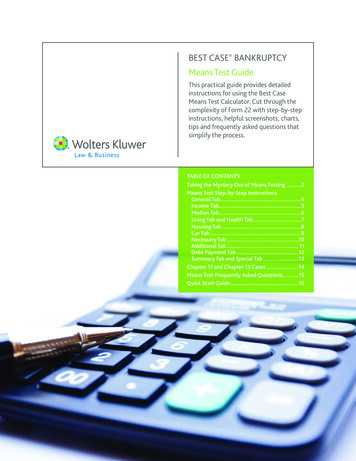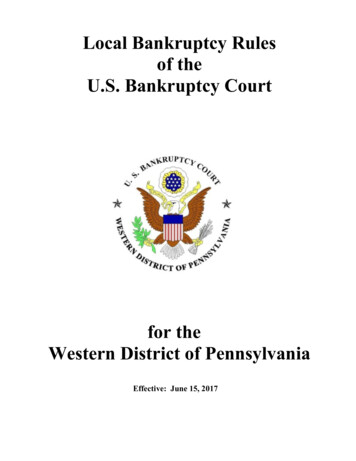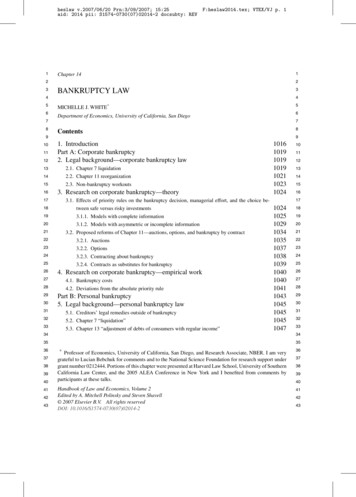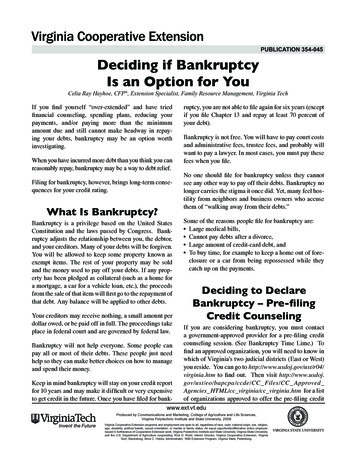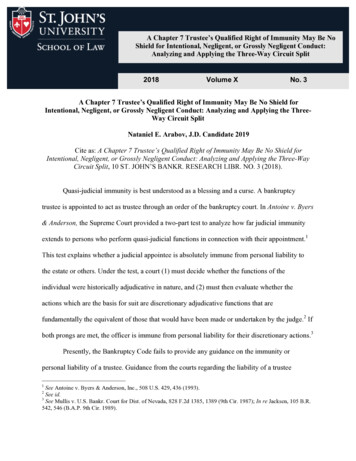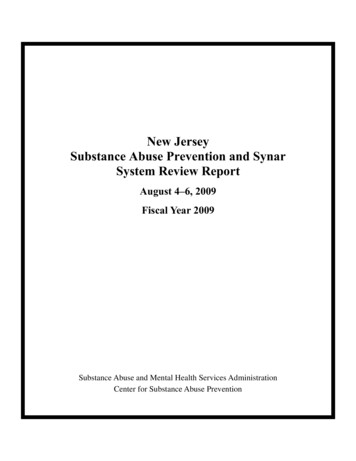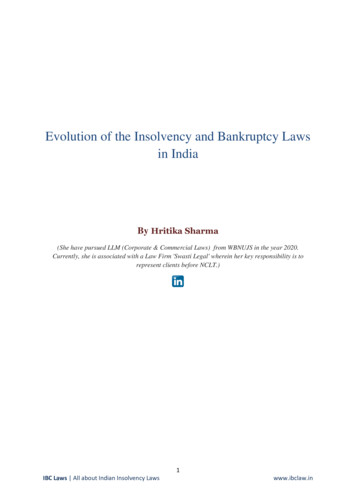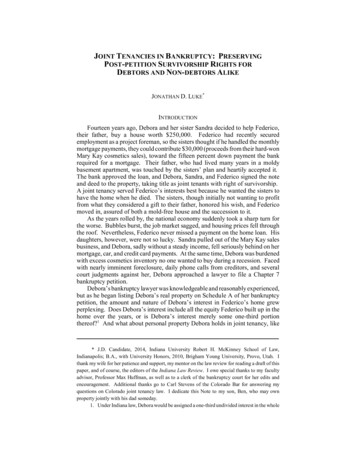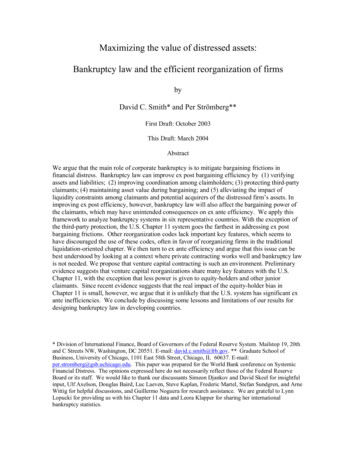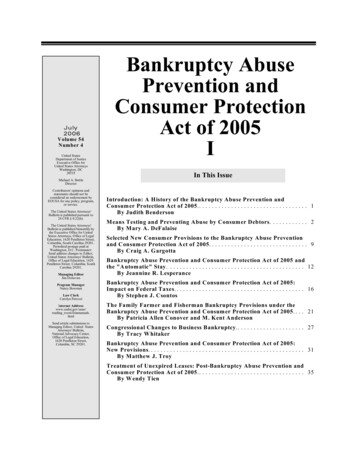
Transcription
July2006Volume 54Number 4United StatesDepartment of JusticeExecutive Office forUnited States AttorneysWashington, DC20535Bankruptcy AbusePrevention andConsumer ProtectionAct of 2005IIn This IssueMichael A. BattleDirectorContributors' opinions andstatements should not beconsidered an endorsement byEOUSA for any policy, program,or service.The United States Attorneys'Bulletin is published pursuant to28 CFR § 0.22(b).The United States Attorneys'Bulletin is published bimonthly bythe Executive Office for UnitedStates Attorneys, Office of LegalEducation, 1620 Pendleton Street,Columbia, South Carolina 29201.Periodical postage paid atWashington, D.C. Postmaster:Send address changes to Editor,United States Attorneys' Bulletin,Office of Legal Education, 1620Pendleton Street, Columbia, SouthCarolina 29201.Managing EditorJim DonovanProgram ManagerNancy BowmanLaw ClerkCarolyn PerozziInternet Addresswww.usdoj.gov/usao/reading room/foiamanuals.htmlSend article submissions toManaging Editor, United StatesAttorneys' Bulletin,National Advocacy Center,Office of Legal Education,1620 Pendleton Street,Columbia, SC 29201.Introduction: A History of the Bankruptcy Abuse Prevention andConsumer Protection Act of 2005. . . . . . . . . . . . . . . . . . . . . . . . . . . . . . . . . . 1By Judith BendersonMeans Testing and Preventing Abuse by Consum er Debtors. . . . . . . . . . . . 2By Mary A. DeFalaiseSelected New Consumer Provisions to the Bankruptcy Abuse Preventionand Consumer Protection Act of 2005. . . . . . . . . . . . . . . . . . . . . . . . . . . . . . . 9By Craig A. GargottaBankruptcy Abuse Prevention and Consumer Protection Act of 2005 andthe "Automatic" Stay. . . . . . . . . . . . . . . . . . . . . . . . . . . . . . . . . . . . . . . . . . . 12By Jeannine R. LesperanceBankruptcy Abuse Prevention and Consumer Protection Act of 2005:Impact on Federal Taxes. . . . . . . . . . . . . . . . . . . . . . . . . . . . . . . . . . . . . . . . . 16By Stephen J. CsontosThe Family Farmer and Fisherman Bankruptcy Provisions under theBankruptcy Abuse Prevention and Consumer Protection Act of 2005. . . . 21By Patricia Allen Conover and M. Kent AndersonCongressional Changes to Business Bankruptcy. . . . . . . . . . . . . . . . . . . . . 27By Tracy WhitakerBankruptcy Abuse Prevention and Consumer Protection Act of 2005:New Provisions. . . . . . . . . . . . . . . . . . . . . . . . . . . . . . . . . . . . . . . . . . . . . . . . . 31By Matthew J. TroyTreatment of Unexpired Leases: Post-Bankruptcy Abuse Prevention andConsumer Protection Act of 2005. . . . . . . . . . . . . . . . . . . . . . . . . . . . . . . . . 35By Wendy Tien
In HonorThis issue of the United States Attorneys' Bulletin is dedicated toJames R. Shively, the former First Assistant United States Attorney for theEastern District of Washington. Mr. Shively served as an Assistant UnitedStates Attorney for over twenty years and as Interim United States Attorneyfrom 2000 to 2001. He held the position of Chief, Criminal Division and Chief,Civil Division during his tenure. Mr. Shively retired from federal service inOctober 2004.Mr. Shively also served his country in the United States Air Force as anF-105 pilot during the height of the Vietnam war. His plane was shot down on May 5, 1967 and he wascaptured by the North Vietnamese and held as a prisoner-of-war (POW) for over five years. He enduredabuse, torture, illness, and hunger at the hands of the guards at the "Hanoi Hilton." He was released fromthe POW camp on February 18, 1973. Upon his return to the United States, he was awarded the SilverStar in recognition of his distinguished military service to this country.Jim passed away on February 18, 2006 and is survived by his wife, Nancy Banta Shively, hisdaughters, Amy Hawk, Jane Shively, Laura Watson, and Nicole Woodland, along with their husbands,and three grandchildren.Mr. Shively was a warm, intelligent, gentle, and compassionate man. His experiences in life taughthim the true meaning and value of life as evidenced by the following quote. "It's not a person's rank orposition that makes them successful in life. Instead, it's how they relate to their friends and family, andwhat they do for their community. That's how you truly measure success." Interview by Airman ChristiePutz with former Captain James Shively, First Assistant United States Attorney, in Spokane, WA(Oct. 24, 2003).Jim will be remembered by his family, friends, and colleagues for his firm commitment to hisprofession and his exemplary service to his country, both as an Assistant United States Attorney and as anAir Force pilot during the Vietnam War.
Introduction: A History of theBankruptcy Abuse Prevention andConsumer Protection Act of 2005Judith BendersonOffice of Legal Programs and PolicyExecutive Office for United States Attorneysn the early 1990s, many practitioners in thebankruptcy community believed that the1978 Bankruptcy Code, Pub. L. No. 95598, 92 Stat. 2549 (1978), the mostcomprehensive redrafting of the bankruptcy lawsof the United States since 1898, generally workedwell, but had evolved into something of a"Christmas tree," with each special interest havingits own exception or carve-out under title 11. Inresponse, Congress passed the BankruptcyReform Act of 1994, Pub. L. No. 103-394, 108Stat. 4106 (1994). Congress made changes to theCode, including an Executive Office forUnited States Attorneys' (EOUSA) proposal tocover criminal bankruptcy schemes, 18 U.S.C.§ 157. Congress indicated that it was generallysatisfied with the basic framework of the Code,but established a blue-ribbon panel, the NationalBankruptcy Review Commission, to study thebankruptcy laws and make recommendations forfurther improvements. The bipartisan Commissionconsisted of nine members appointed by thePresident, the Congress, and the Judiciary. TheCommission delivered its Final Report in 1997.See N AT 'L B ANKR . R EVIEW C OMM 'N , F INALR EPORT , B ANKRUPTCY : T HE N EXT T WENTYY EARS (Commission Print Oct. 20, 1997).Initially, although Congress authorized theCommission, it did not appropriate the necessaryfunding. Its first chairman spent months gettingfunding, but died shortly after it was obtained.Eventually, a new chairman was appointed andthe Commission got about its business. The workwas divided into particular areas and expertworking groups were formed to address: (1)chapter 11; (2) consumer bankruptcy; (3)government; (4) jurisdiction and procedure; (5)mass torts and future claims; (6) service to theestate and ethics; (7) small business, partnerships,and single asset real estate; and (8) transnationalbankruptcies. In addition, there was a ten-membertax advisory committee comprised of federal andIJ U LY 2006state government representatives, academics, andpractitioners. Input was solicited from groupsacross the bankruptcy spectrum, including theDepartment of Justice, some of which is reflectedin the recent legislation.One area, however, that was extremelycontroversial from the outset, and created a longand tortured path for legislative change,concerned consumer or individual bankruptcy.Before the October 1997 delivery of theCommission's Final Report to the Chief Justice,legislation in sharp disagreement with the Reports'consumer provisions was introduced. Thecontroversy within the bankruptcy communitywas, and continues to be, whether or not it is tooeasy for individual debtors to "abuse" thebankruptcy system. Abuse is defined asdischarging debts which debtors theoreticallycould afford, at least in part, to pay. All sidesprovided anecdotes, but few official statisticsexisted to support them.The legislation did, however, include newrequirements for gathering statistics by theAdministrative Office of the U.S. Courts. The1997 bill was unsuccessful but, like the phoenix,rose repeatedly from the ashes in some curiouslycreative ways. In 2000, for example, in order toget the bill directly to the floor for a vote, theSenate Judiciary Committee carved out the entirecontents of an unneeded State Department billwhich had already passed a committee, andinserted the language of the bankruptcylegislation. The bill made it to the President'sdesk, but was pocket vetoed. The bill was alsostymied by controversial language inserted inresponse to bankruptcy being filed to avoidpaying damages to doctors who were injured aftertheir photographs and personal information wasposted on a Web site protesting abortion rights. In2005, it was felt that because of the compositionof Congress, the language could be removed andthe bill would pass. The President signed theBankruptcy Abuse Prevention and ConsumerProtection Act of 2005, Pub. L. No. 109-8, 119Stat. 23 (2005) on April 20 of that year.There was a dramatic increase in the numberof filings in the weeks and days leading up to theU N ITED S TATES A TTO RN EY S ' BU LLETIN1
effective date (Oct. 17, 2005). According to TheThird Branch, the newsletter of theAdministrative Office of the U.S. Courts, inOctober 2005, more than 600,000 bankruptcycases were filed nationwide. New Law CreatesRush to File in Federal Courts, T HIRD B RANCH(Fed. Courts Newsletter), Nov. 2005, at Vol. 37,No. 11, available at dex.html. By comparison,in October 2004, filings totaled only 130,679. Id.There was an equally dramatic drop-off in theweeks following the effective date. This may bedue to the massive number of bankruptcyapplications filed before the effective date, as wellas practitioners who were in a holding patternconcerning the effect of the provisions of the newlaw.In August 2005, the Bankruptcy RulesCommittee issued Interim Rules because of thetime constraints involved in addressing thelegislative changes that corresponded with theslower moving rules process. These can be foundon the U.S. Federal Courts Bankruptcy page,available at http://www.uscourts.gov/bankruptcycourts.html. The Committee is in theprocess of addressing the required changes and,until this task is accomplished, the Interim Rulesare in effect.In the meantime, most of the U.S. Attorneys'offices are busy with the case backlog under theold law and old rules. ABOUT THE AUTHOR Judith Benderson is currently serving as theAttorney/Bankruptcy Coordinator, Office of LegalPrograms and Policy at the Executive Office forUnited States Attorneys. Prior to being detailed tothis position, she was assigned to EOUSA as theAmerican Political Science AssociationCongressional Fellow. She was detailed to theNational Bankruptcy Review Commission asLegislative Counsel and Press Officer.aMeans Testing and Preventing Abuseby Consumer DebtorsMary A. DeFalaiseTrial AttorneyFinancial Litigation SectionCommercial Litigation BranchCivil DivisionI. Introductionne of the biggest changes made to theBankruptcy Code by the BankruptcyAbuse Prevention and ConsumerProtection Act of 2005, Pub. L. No. 109-8, 119Stat. 23 (BAPCPA), is the inclusion of the "meanstest" for consumer cases. Before BAPCPA,debtors were allowed to unconditionally dischargeO2certain personal debts through the liquidation anddistribution of their non-exempt assets. See H.R.Rep. No. 109-31(I), at 10-11, as reprinted in 2005U.S.C.C.A.N. 88, 96-97. In 1938, Congressrecognized that individual debtors should beallowed to pay off at least some of their debt andcodified a debtor's choice to pay creditors throughan extended repayment plan. Id. This choice,however, was completely voluntary. Id. Today,total or partial repayment of consumer debt isdone through a three or five year payment planunder chapter 13 of the Bankruptcy Code,whereas a discharge of consumer debt isaccomplished by filing for relief under chapter 7of the Bankruptcy Code.U N ITED S TATES A TTO RN EY S ' B U LLETINJ U LY 2006
Although a debtor's right to seek a dischargeof consumer debt under chapter 7 was unfetteredfor many years, Congress eventually limited theconsumer debtor's "unconditional" dischargethrough a series of amendments to the BankruptcyReform Act of 1978, Pub. L. No. 95-598, 92 Stat.2549. See Eugene R. Wedoff, Means Testing inthe New § 707(B), 79 A M . B ANKR . L.J. 231, 23334 (2005) (discussing pre-BAPCPA bankruptcyamendments and legislative history). Theseamendments were aimed at curbing abuse byconsumer debtors who could repay some of theirpersonal debts, but avoided their obligations byfiling for chapter 7. H.R. Rep. No. 109-31(I), at12, 98. The amendments allowed the court todismiss a chapter 7 case for cause, substantialabuse, or, under certain circumstances, by motionof the United States Trustee. Id. at 11-12, 98.Notwithstanding these amendments, the formerBankruptcy Code still favored granting dischargesto individual debtors. Id. at 12, 98. Thebankruptcy courts were also divided over whatconstitutes "substantial abuse," creating varyingcriteria for dismissing a chapter 7 case. See id. Seealso In re Hardacre, No. 05-95518, 2006 WL541028 *1 (Bankr. N.D. Tex. Mar. 6, 2006)(acknowledging former § 707(b) did not define"substantial abuse"); In re Johnson, 318 B.R. 907,919 (Bankr. N.D. Ga. 2005) (stating that courtsgiven discretion to determine substantial abuse ona case-by-case basis); In re Attanasio, 218 B.R.180 (Bankr. N.D. Ala. 1998) (listing casesanalyzing "substantial abuse").Consequently, Congress enacted BAPCPA tolimit abuse by consumer debtors and reform thebankruptcy system. BAPCPA eliminates thepresumption in favor of discharging debtors'liabilities and allows a chapter 7 case to bedismissed for abuse, rather than substantial abuse.11 U.S.C. § 707(b)(1). Moreover, BAPCPAestablishes a "means test" to determine whether apresumption of abuse exists in cases filed underchapter 7. See generally 11 U.S.C. § 707(b)(2).The "means test" is designed to identify debtorswho can afford to make payments to creditors andprevent them from filing a chapter 7 bankruptcycase. See John Hennigan, Rousey and the NewRetirement Funds Exemption, 13 A M . B ANKR .INST . L. R EV . 777, 798 (Winter 2005)(summarizing means test under BAPCPA). Thefollowing describes how to determine whether apresumption of abuse arises under the new chapter7 means test, how such presumption may berebutted, new certification requirements forJ U LY 2006debtors' attorneys, and other additions to theBankruptcy Code intended to curb consumerabuse.II. Determining whether a presumptionof abuse existsUpon filing for relief under chapter 7, a debtoris now required to file a "Statement of CurrentMonthly Income And Means Test Calculation"(Bankruptcy Form B22A). In addition, the debtormust also file a schedule of current income(Schedule I) and schedule of current expenses(Schedule J). This statement is a worksheet usedto determine whether seeking relief under chapter7 is presumptively abusive. If, after deductingallowable expenses from the debtor's currentmonthly income (CMI), the debtor's disposalmonthly income exceeds either (i) the greater of 100 or 25 percent of the debtor's nonpriorityunsecured claims, or (ii) 166.67, a presumptionof abuse arises. 11 U.S.C. § 707(b)(2)(A).Determining the debtor's disposable monthlyincome starts by calculating the debtor's CMI. TheBankruptcy Code defines CMI as the averagemonthly income received by the debtor from allsources (regardless of whether such income istaxable income), for the six months prior to filing,ending on the last day of the calendar monthimmediately preceding the date of thecommencement of the case, if the debtor filed aSchedule I. 11 U.S.C. § 101(10A)(A). If thedebtor did not file a Schedule I, the date on whichthe court determines current income controls. Id.This income includes amounts paid by an entity,other than the debtor, on a regular basis forhousehold expenses, excluding social securitybenefits and victim payments resulting from warcrimes, crimes against humanity, and paymentsresulting from acts of international or domesticterrorism. 11 U.S.C. § 101(10A)(B).Next, the debtor deducts allowable expensesfrom his or her CMI. Allowable expenses thatmay be deducted include those expenses specifiedunder the National Standards and LocalStandards, and the debtor's actual monthlyexpenses for the categories specified as "OtherNecessary Expenses," defined in the CollectionFinancial Standards issued by the InternalRevenue Service (IRS). 11 U.S.C.§ 707(b)(2)(A)(ii)(I). The IRS' National StandardsU N ITED S TATES A TTO RN EY S ' BU LLETIN3
include amounts for: (1) food; (2) housekeepingsupplies; (3) apparel and services; (4) personalcare products and services; and (5) miscellaneousexpenses. Tables setting forth actual amounts forthese expenses, as well as median income andcensus bureau information, can be found .htm.In addition to the expenses listed by the IRS, adebtor may also deduct: (1) costs for reasonablynecessary health insurance; (2) costs for disabilityinsurance; (3) amounts for certain health savingsaccounts; (4) reasonably necessary costsassociated with protecting the debtor and thedebtor's family from acts of violence under federallaw; and (5) actual amounts, up to 1,500 a year(under certain conditions) that are not accountedfor by any of the other allowable expenses foreach of the debtor's minor, dependant childrenwho attend a private or public elementary orsecondary school. 11 U.S.C. § 707(b)(2)(A)(ii)(I),(IV). Other allowable deductions includereasonable and necessary: (1) costs to continue thecare and support of an elderly, chronically ill ordisabled household member (or member of thedebtor's immediate family who is unable to paysuch costs); (2) amounts for home energy costs inexcess of those amounts specified in theCollection Financial Standards for which thedebtor can provide documentation; and (3)additional amounts not to exceed 5 percent of theNational Standards for food and clothing. 11U.S.C. §§ 707(b)(2)(A)(ii)(II), (V). Debtors whoare eligible to file under chapter 13 may alsodeduct from their CMI actual administrativeexpenses associated with administering a chapter13 plan which do not exceed 10 percent of theprojected plan payments. 11 U.S.C.§ 707(b)(2)(A)(ii)(III).Although debtors can not deduct payments fordebts as a monthly expense, see 11 U.S.C.§ 707(b)(2)(A)(ii)(I), debtors' payments forsecured debts and priority debts are accounted forwhen determining monthly disposable income.See, e.g., In re Nuttall, 334 B.R. 921, 924 (Bankr.W.D. Mo. 2005); In re Hill, 328 B.R. 490, 502(Bankr. S.D. Tex. 2005). Debtors are allowed todeduct their average monthly payments forsecured and priority debts from their CMI beforedetermining whether their disposable monthlyincome exceeds the amounts described in 11U.S.C. § 707(b)(2)(A). Id. A debtor's averagemonthly payment for a secured debt is calculated4by taking the total of all amounts contractuallydue over sixty months, starting from the monththe petition is filed, and dividing such amount bysixty. 11 U.S.C. § 707(b)(2)(A)(iii). Amounts forpriority claims are also calculated by taking thetotal amount of debt entitled to priority (includingpriority child support and alimony claims) anddividing by sixty. 11 U.S.C. § 707(b)(2)(A)(iv).Again, if, after deducting these amounts andallowable expenses, a debtor's disposable monthlyincome exceeds the amounts described in 11U.S.C. § 707(b)(2)(A), the debtor's bankruptcycase will be presumed abusive.III. Notice of presumption of abuseIf a presumption of abuse arises under§ 707(b), the clerk must give notice to all of thedebtor's creditors of such presumption within tendays after the debtor files for relief under chapter7. 11 U.S.C. § 342(d). The United States Trusteewill subsequently hold a first meeting of creditorswithin twenty to sixty days of the filing of thepetition for relief. 11 U.S.C. § 341(a); F ED . R.B ANKR . P. 2003(a). Within ten days after the firstmeeting of creditors, the United States Trustee(which, for the purposes of this article, includesbankruptcy administrators) must file a statementwith the court stating that: (1) the debtor's case ispresumed to be an abuse under § 707(b); (2) apresumption of abuse does not exist; or (3) thedebtor failed to submit the appropriate documentsto complete the means test. See 11 U.S.C.§ 704(b)(1)(A). See also In re Fawson, No.05-80244, 2006 WL 398182 *1 (Bankr. D. UtahFeb. 21, 2006) (trustee forced to file notice thatdebtor failed to file or transmit necessary meanstesting documents). If the debtor fails to providethe trustee the information required under § 521,the case will be dismissed after forty-five days.See 11 U.S.C. § 521(i); Fawson, 2006 WL398182 at *6 (dismissing case under § 521(i)where debtor failed to request enlargement of timeto file required documentation).The court must provide a copy of theUnited States Trustee's statement to the creditorsin the debtor's case within five days afterreceiving the statement. 11 U.S.C.§ 704(b)(1)(B).If a presumption of abuse exists, then theUnited States Trustee must decide whether to filea motion to dismiss or convert the debtor's caseunder § 707(b), or determine whether specialcircumstances warrant an exception. 11 U.S.C.§ 704(b)(2). The United States Trustee has thirtyU N ITED S TATES A TTO RN EY S ' B U LLETINJ U LY 2006
days to make this decision, and if no motion isfiled, the trustee must file a statement explainingwhy such motion would not be appropriate. Id. Ifa motion to dismiss or convert is filed and thedebtor objects, the court must conduct a trialwhere the debtor will have to overcome thepresumption of abuse. If the debtor cannot rebutthe presumption, the debtor's case will beconverted to a chapter 11 or chapter 13 case, or bedismissed. 11 U.S.C. § 707(b)(1).If no presumption of abuse exists or thedebtor rebuts such presumption, the court mustdetermine whether granting the debtor reliefwould be an abuse of the Bankruptcy Code. 11U.S.C. § 707(b)(3). To make this determination,the court must consider whether the debtor filedthe petition in bad faith or if the totality of thecircumstances demonstrates abuse. 11 U.S.C.§ 707(b)(3)(A)-(B). The circumstances the courtconsiders include whether the debtor filed forrelief to reject a personal services contract and thedebtor's financial need to reject such a contract. 11U.S.C. § 707(b)(3)(B). Thus, even if apresumption of abuse does not arise, the courtmay still conclude that granting chapter 7 relief tothe debtor is abusive. See Hill, 328 B.R. at 507.Thereafter, if the court finds that grantingrelief in the case would be an abuse of theBankruptcy Code, the court, on its own or bymotion of the United States Trustee or any partyin interest, may move to dismiss the debtor's case.11 U.S.C. § 707(b)(1). In making such a finding,the court can not consider whether the debtormade, or continues to make, charitablecontributions to any qualified religious orcharitable entity or organization as those terms aredefined under § 548(d) of the Bankruptcy Code.Id. If the court determines that the debtor's casewould constitute an abuse under chapter 7, thecase will be converted or dismissed. 11 U.S.C.§ 707(b)(1).expense or adjustment to CMI, the debtor mustprovide supporting documentation, provide adetailed explanation of why the specialcircumstances make the additional expense oradjustment reasonable and necessary, and attestunder oath as to the accuracy of the supportinginformation provided. 11 U.S.C.§§ 707(b)(2)(B)(ii)-(iii). The presumption ofabuse will only be rebutted if the additionalexpenses or adjustments cause the debtor's CMI tobe less than: the lesser of "(I) 25 percent of thedebtor's non-priority claims, or 6,000, whicheveris greater; or (II) 10,000." 11 U.S.C.§ 707(b)(2)(B)(iv).Certain disabled veterans are exempt frommeans testing and do not have to rebut apresumption of abuse. Specifically, any disabledveteran (as defined in 38 U.S.C. § 3741(1)) whoincurred his or her indebtedness while on activeduty or while performing a homeland defenseactivity (as defined in 32 U.S.C. § 901(1)) is notsubject to means testing or rebutting apresumption of abuse. 11 U.S.C. § 707(b)(2)(D).If the debtor qualifies for this exception, a courtcannot dismiss or convert such a debtor's casebased on means testing. Id.V. "Safe harbors" against means testingBAPCPA provides two "safe harbors" toprotect lower income debtors from their creditors.H.R. Rep. No. 109-31, at 15, 51, 381, 485 (2005).See Wedoff, supra at 238. First, only a judge orthe United States Trustee may file a motion todismiss or convert a case under § 707(b) if thedebtor's CMI (or the debtor's and debtor's spouse'sCMI in a jointly filed case), when multiplied bytwelve, at the time the order for relief is entered, isequal to or less than:IV. Rebutting the presumption of abuseA presumption of abuse may be rebutted byshowing exceptional circumstances if thecircumstances justify additional expenses or anadjustment to CMI for which there is noreasonable alternative. 11 U.S.C.§ 707(b)(2)(B)(i). See Hardacre, 2006 WL541028 at *2. Exceptional circumstances includeserious medical conditions and being called toactive military duty. Id. For each additionalJ U LY 2006U N ITED S TATES A TTO RN EY S ' BU LLETIN5
The median familyincome of theapplicable state for oneearner. . .if the debtor is in ahousehold of oneperson.The median familyincome of theapplicable state for oneearner. . .if the debtor is in ahousehold of oneperson.The highest medianfamily income of theapplicable state for afamily of the samenumber or fewerindividuals. . .if the debtor is in ahousehold of twofour individuals.The highest medianfamily income of theapplicable state for afamily of the samenumber or fewerindividuals. . .if the debtor is in ahousehold of twofour individuals.The same as ahousehold with twofour individuals, plus 525 per month foreach individual inexcess of four. . .if the debtor is in ahousehold exceedingfour individuals.The same as ahousehold with twofour individuals, plus 525 per month foreach individual inexcess of four. . .if the debtor is in ahousehold exceedingfour individuals.11 U.S.C. § 707(b)(6). For any year, medianfamily income means the median family incomeboth calculated and reported by the Bureau of theCensus in the then most recent year. 11 U.S.C.§ 101(39A). If such calculation is not done orreported in the then current year, median familyincome is determined by adjusting annually, afterthe most recent year, the increase in the ConsumerPrice Index (CPI) for All Urban Consumersduring the period between the most recent yearand the current year. Id.Second, no one can file a motion to dismissunder § 707(b)(2) based on the ability of a debtor,including veterans, to repay debts if the debtor'sand the debtor's spouse's CMI, when multiplied bytwelve at the time the order for relief is entered, isequal to or less than:611 U.S.C. § 707(b)(7)(A). The CMI of thedebtor's spouse is not considered in thiscalculation if: (1) the case is not jointly filed; (2)the debtor and his or her spouse are legallyseparated, or living separate and apart; and (3)they are doing so for purposes other than trying toqualify the debtor for this exception. 11 U.S.C.§ 707(b)(7)(B). To qualify for this exception,debtors must also file a statement, under thepenalty of perjury, that they are legally separated,or living separate and apart, and disclose anyaggregate amounts that they may be receivingfrom their spouse that contribute to their CMI. 11U.S.C. § 707(b)(7)(B)(ii).VI. Certifications by debtors' attorneysBesides requiring an immediate determinationwhether presumed abuse exists, BAPCPA alsorequires more accountability on the part ofdebtors' attorneys. See 11 U.S.C. § 707(b)(3)(C).By signing a petition, pleading, or motion, anattorney is deemed to have certified that theattorney: "(i) performed a reasonable investigationinto the circumstances that gave rise to theparticular petition, pleading, or written motion;and (ii) determined that such document is wellgrounded in fact; and is warranted under existinglaw. . . ." Id. The attorney may also argue thatexisting law should be reversed or modified aslong as such argument is made in good faith anddoes not constitute an abuse of the BankruptcyCode. 11 U.S.C. § 707(b)(3)(C)(ii). Further, theU N ITED S TATES A TTO RN EY S ' B U LLETINJ U LY 2006
attorney's signature on the debtor's petition forrelief constitutes a certification that the attorneyhas made an inquiry as to the informationcontained in the debtor's bankruptcy schedulesand has no knowledge that the informationcontained in such schedules is incorrect. 11U.S.C. § 707(b)(3)(D).If a United States Trustee files a motion todismiss or convert a debtor's case under § 707(b),the court may order that the debtor's attorneyreimburse the trustee for all reasonable costs inprosecuting the motion, if such motion issuccessful and the court finds that, by filing thedebtor's case under chapter 7, the debtor's attorneyviolated Rule 9011 of the Federal Rules ofBankruptcy Procedure. 11 U.S.C.§ 707(b)(4)(A)(i)-(ii). On its own, or by motion ofan interested party, the court may also assess anappropriate civil penalty against the debtor'sattorney and order that such penalty be turnedover to the United States Trustee in accordancewith the procedures set forth in Bankruptcy Rule9011. 11 U.S.C. § 707(b)(4)(B). A debtor,however, may be awarded reasonable costs incontesting a motion for sanctions brought by aparty in interest (but not the United StatesTrustee) if the court does not grant the sanctionsmotion and: (1) the position of the movantviolated Bankruptcy Rule 9011; or (2) theattorney did not conduct a reasonableinvestigation before filing the motion thatcomplied with the requirements of 11 U.S.C.§ 707(b)(3)(C)(ii) and was made solely for thepurpose of coercing a debtor into waiving his orher rights under the Bankruptcy Code. 11 U.S.C.§ 707(b)(5)(A).VII. Other BAPCPA provisionscurtailing abuse and fraudBAPCPA also includes many other notableadditions aimed at curbing consumer abuse andfraud. For instance, BA
and tortured path for legislative change, concerned consumer or individual bankruptcy. Before the October 1997 delivery of the Commission's Final Report to the Chief Justice, legislation in sharp disagreement with the Reports' consumer provisions was introduced. The controversy within the bankruptcy community

